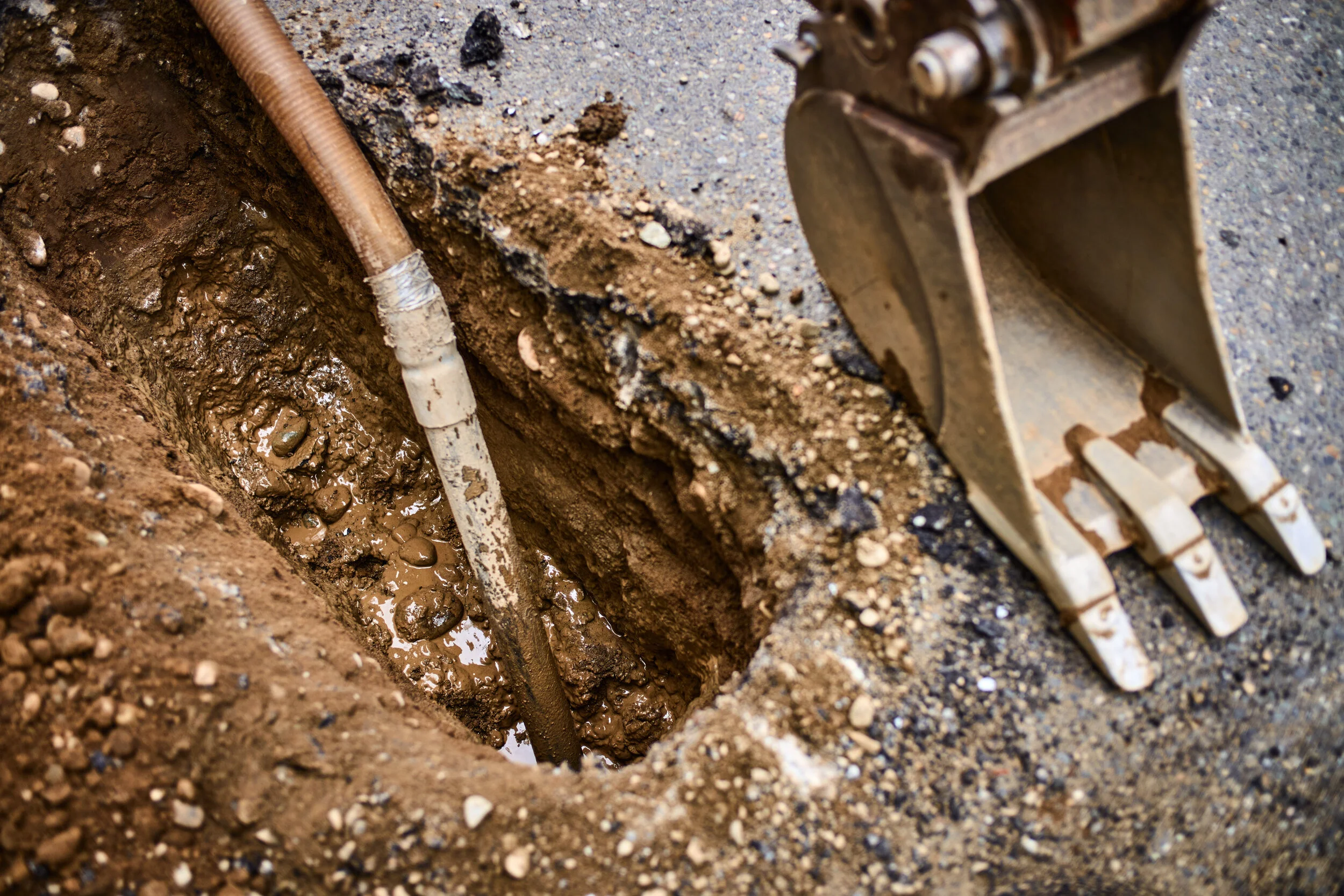
What is
Directional
Drilling?
Directional drilling (HDD) eliminates the need for traditional open trenches by using specialized equipment to drill horizontally, or at custom angles. This minimizes disruption to the surrounding area and preserves property aesthetics. Directional drilling is highly suitable for residential construction. It enables the installation of utilities, such as water lines, sewer lines, and electrical conduits, without extensive disruption to properties.
Here’s what you need to know.
| Traditional Trenching | Directional Boring | |
|---|---|---|
| Time Efficiency | Time-consuming excavation and restoration process | Streamlined installation with minimal disruption |
| Property Disruption | Extensive property damage and disturbance | Preserves property aesthetics, minimizing restoration |
| Project Cost | Higher labor and material costs | Cost-effective solution with reduced labor and materials |
| Environmental Impact | Ecological disruption and soil disturbance | Minimizes environmental footprint and disturbance |
| Project Flexibility | Limited routing options and constraints | Flexible path selection for optimum utility placement |
| Longevity | Higher risk of damage or degradation over time | Durable, reliable installations built to last |
Did you know?
90% of general contractors who adopted directional boring reported improved project timelines and client satisfaction.
Directional boring has been proven to reduce project costs by up to 30% compared to traditional trenching methods.
A study showed that directional boring results in 80% less restoration work, saving valuable resources and time.
-

Efficiency
Directional boring slashes construction timelines, allowing you to complete projects faster. Our streamlined process minimizes excavation, eliminating time-consuming restoration and ensuring project delivery within tight deadlines.
-

Preserve Property Integrity
With directional boring, you can maintain the aesthetics and functionality of the property. Say goodbye to disruptive trenches and extensive damage. Homeowners will appreciate the minimal impact on their surroundings.
-

Cost-Effective
Our approach offers significant cost savings. Reduced labor and material requirements, along with minimized property restoration, translate into a more budget-friendly option for your projects.
-

Environmentally Conscious
Directional boring aligns with eco-friendly practices. By minimizing ecological disruption and soil disturbance, you contribute to a greener construction process, ensuring a better future for generations to come.
30 ft
Maximum depth of bore.
1000 ft
Maximum length of a bore without “daylighting” in one shot. Multiple shots can be connected for much longer runs.
16 inch
Maxmium diameter of pipes per pull.
Service Catalogue
F.A.Q.
The most frequently asked questions from our customers.
-
Directional drilling is a cutting-edge technique that allows for the precise installation of underground utilities or infrastructure by drilling at specific angles and directions. It offers greater flexibility and minimizes the need for extensive excavation.
-
Directional drilling eliminates the need for traditional open trenches by using specialized equipment to drill horizontally, vertically, or at custom angles. This minimizes disruption to the surrounding area and preserves property aesthetics.
-
Directional drilling offers benefits such as reduced property disruption, faster project timelines, cost savings, flexibility in utility routing, environmental friendliness, and enhanced client satisfaction.
-
Directional drilling is highly suitable for residential construction. It enables the installation of utilities, such as water lines, sewer lines, and electrical conduits, without extensive disruption to homeowners' properties.
-
Directional drilling can install various utilities, including water lines, sewer lines, natural gas pipelines, electrical conduits, telecommunications cables, and fiber optic lines, among others.
-
Directional drilling often proves cost-effective due to reduced labor and restoration costs. While upfront expenses may vary depending on project specifics, the long-term savings from minimized disruption and restoration outweigh traditional trenching costs.
-
Directional drilling significantly reduces project timelines by eliminating the need for extensive excavation and restoration. The streamlined process expedites installations, leading to faster project completion.
-
Yes! Directional drilling is highly versatile and can navigate areas with limited space or obstacles. Its ability to drill around or under existing structures, utilities, or landscape features makes it ideal for challenging locations.
-
Feasibility depends on factors like soil conditions, geological formations, utility requirements, environmental considerations, regulatory requirements, space availability, and the presence of obstacles.
-
Directional drilling requires specialized equipment, including drilling rigs, drill bits, reamers, mud mixing systems, tracking and guidance systems, and support vehicles. The specific equipment used depends on project requirements.
-
Safety is paramount in directional drilling. Adequate safety measures include site evaluations, proper training for personnel, adherence to industry standards, regular equipment maintenance, and the use of safety protocols to minimize risks.
-
Directional drilling minimizes disruption by using drilling techniques that create small entry and exit points, reducing the need for large-scale excavation. This preserves the aesthetics and integrity of existing landscapes.
-
Yes, directional drilling can be performed in environmentally sensitive areas. Its minimal environmental footprint and ability to work around sensitive ecosystems make it a suitable choice for environmentally conscious projects.
-
While highly versatile, directional drilling may face limitations in certain situations such as extremely hard rock formations, excessive depth requirements, or the presence of unforeseen underground obstacles. However, skilled operators can often overcome such challenges.
-
Directional drilling ensures long-term benefits by providing durable and reliable utility installations. These installations have fewer vulnerabilities to damage, require minimal maintenance, and offer excellent longevity.
-
Directional drilling utilizes specialized drill bits and drilling fluids suited for different soil and geological conditions. Skilled operators adapt drilling techniques to navigate through varying formations, including hard rock, clay, sand, and more.
-
Absolutely! Directional drilling is applicable to both new construction and retrofitting projects. It enables the installation or replacement of utilities in existing structures or during the construction of new ones.
-
Permits and approvals vary by location and project scope. Depending on the jurisdiction, you may require permits related to environmental impact, construction, utility connections, right-of-way access, or traffic control.
-
Utilities installed using directional drilling are designed for long-term durability. Their typical lifespan matches or exceeds that of utilities installed through traditional trenching methods, ensuring reliable service for decades.
-
Directional drilling minimizes disruption to adjacent properties as it avoids extensive excavation and reduces noise, vibration, and dust compared to traditional trenching. This helps maintain harmonious relations with neighboring properties.
-
Before directional drilling, comprehensive utility locates are performed using technologies like ground-penetrating radar, electromagnetic locators, and utility markouts. This ensures accurate mapping and identification of existing utilities and potential obstacles.
-
Directional drilling minimizes the impact on existing infrastructure by drilling around or beneath it, thereby avoiding disruptions or damage. This allows for the installation of new utilities without interfering with the functionality of existing ones.
-
Yes, directional drilling is commonly used for crossing water bodies, environmentally sensitive areas, or protected lands. It offers a non-disruptive method to install utilities without disturbing aquatic ecosystems or ecologically important areas.
-
Various regulations and industry standards govern directional drilling, ensuring safety, environmental protection, and adherence to best practices. Compliance with local, state, and federal guidelines is essential for successful and responsible project execution.
-
Directional drilling aligns with sustainable construction practices by minimizing environmental disruption, reducing material waste, conserving resources, and lowering energy consumption associated with traditional excavation methods.
-
Directional drilling is advantageous in urban or densely populated areas because it minimizes disruption to traffic flow, reduces noise and dust, and preserves property aesthetics. It allows for the efficient installation of utilities without inconveniencing residents.
-
Directional drilling can be performed in freezing or extreme weather conditions with proper equipment and safety measures in place. However, project feasibility may depend on factors such as ground conditions, equipment capabilities, and safety considerations.
-
There are numerous case studies and success stories highlighting the effectiveness of directional drilling. These real-world examples demonstrate significant time savings, cost reductions, improved project efficiency, and enhanced client satisfaction in a variety of construction projects.
Our Stories and Info section has some examples.








